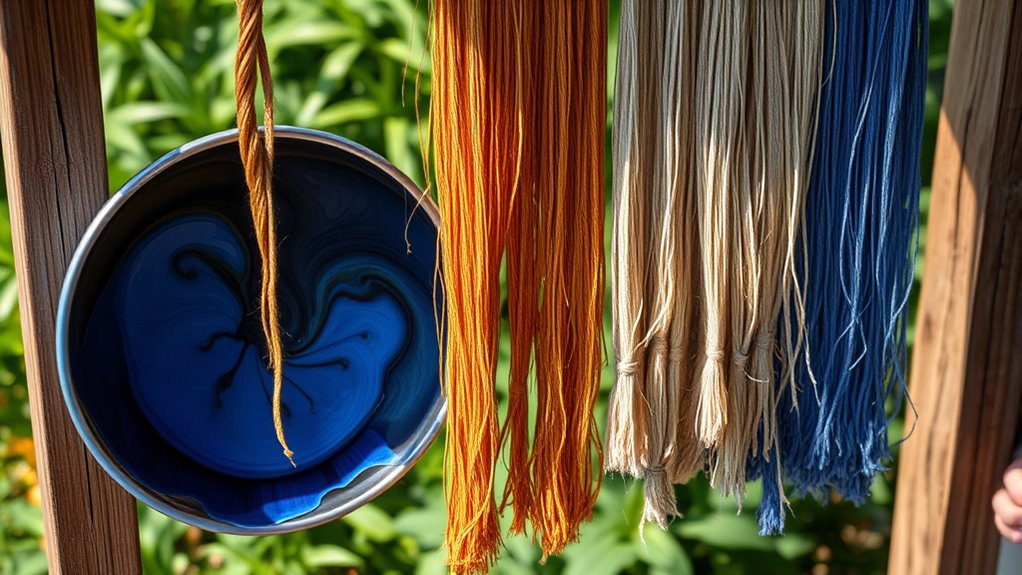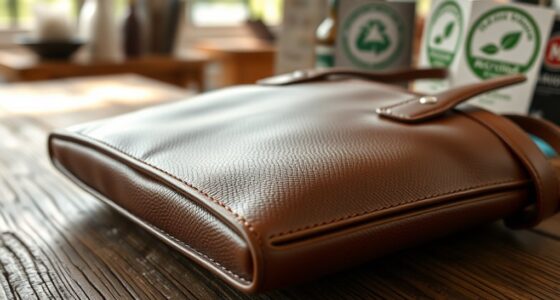Sustainable dyeing techniques are transforming the accessory industry by reducing water use, eliminating harmful chemicals, and incorporating eco-friendly materials like natural, microbial, and bio-based dyes. Waterless processes, digital printing, and energy-efficient systems powered by solar energy help cut waste and pollution. Using recycled and upcycled fabrics further lowers environmental impact. To discover how these innovations are shaping a greener future, stay tuned for more insights into eco-conscious dyeing methods.
Key Takeaways
- Natural and microbial dyes offer eco-friendly, biodegradable coloring options reducing chemical waste in accessory production.
- Waterless and digital dyeing techniques significantly cut water usage and minimize environmental impact during manufacturing.
- Recycled and upcycled materials, combined with low-impact dyes, promote waste reduction and unique, sustainable accessory designs.
- Solar-powered and energy-efficient dyeing systems lower carbon footprints while maintaining high-quality, vibrant colors.
- Certification standards like GOTS and OEKO-TEX ensure transparency and adherence to sustainable dyeing practices in the industry.
Natural Dyes From Plant-Based Sources
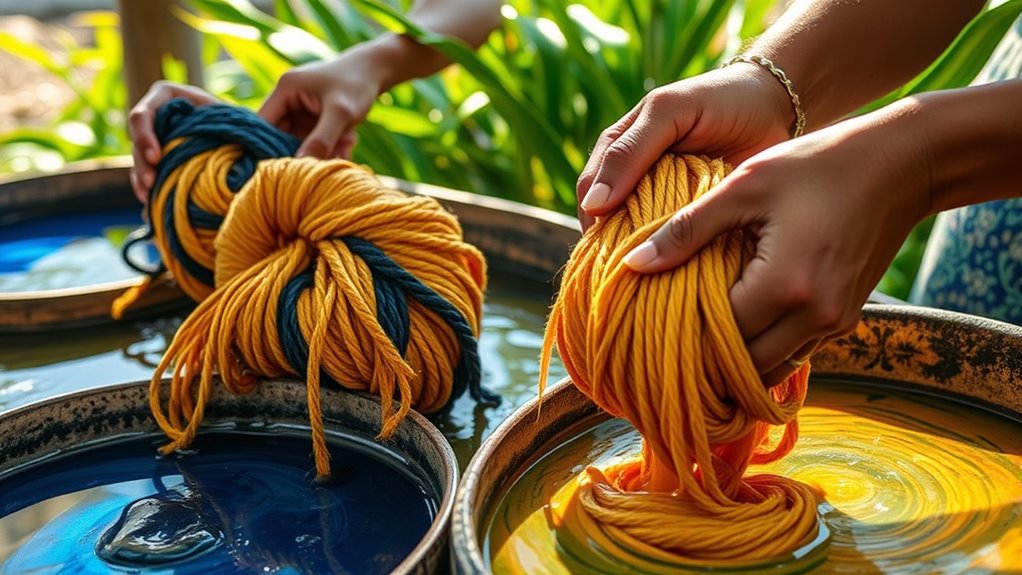
Natural dyes derived from plant-based sources offer a sustainable alternative to synthetic coloring methods. You can extract vibrant colors through plant extraction, which harnesses natural pigmentation from leaves, roots, berries, and flowers. This process not only reduces reliance on harmful chemicals but also minimizes environmental impact. By using plant-based sources, you’re tapping into renewable resources that can be cultivated sustainably. The natural pigmentation obtained through plant extraction provides rich, earthy tones that enhance the authenticity of your accessories. Additionally, these dyes are biodegradable and less toxic, making them safer for both the environment and workers involved in the dyeing process. Embracing plant-based natural dyes allows you to create beautiful, eco-friendly products that meet the growing consumer demand for sustainability.
Waterless and Less Water-Intensive Dyeing Methods
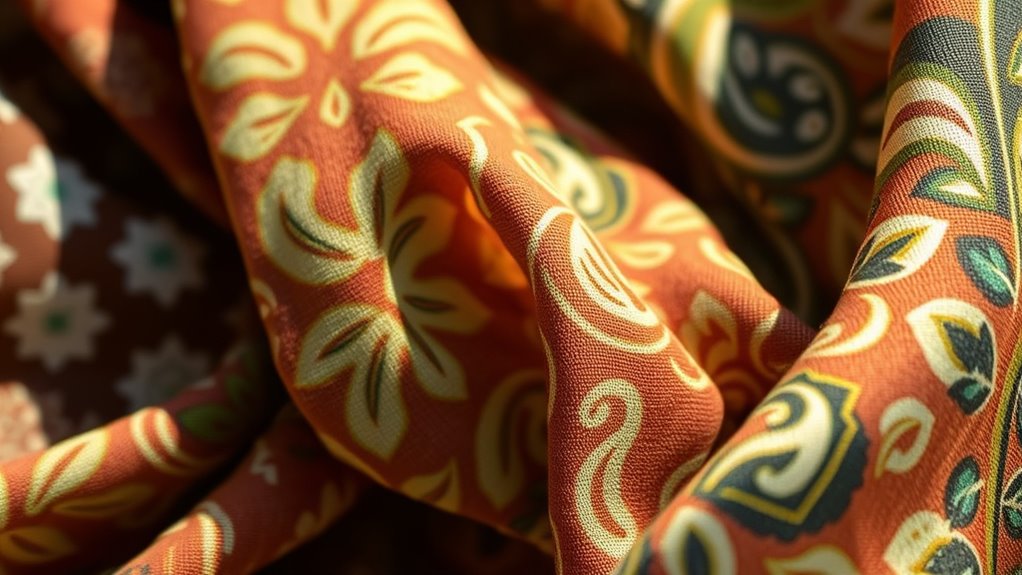
Waterless and less water-intensive dyeing methods help you profoundly reduce water consumption in textile production. These innovative technologies not only conserve water but also lower energy use and pollution. By adopting these techniques, you contribute to a more sustainable and eco-friendly fashion industry. Utilizing advanced dyeing technology can further enhance efficiency and environmental benefits in textile manufacturing.
Water Conservation Benefits
Have you ever wondered how the textile industry can reduce its water footprint? Water savings are a key benefit of innovative, waterless, and less water-intensive dyeing techniques. These conservation methods considerably cut down water usage compared to traditional dyeing processes, which often rely on large volumes of water to achieve vibrant colors. By adopting these sustainable methods, you can help preserve essential water resources and lower the industry’s environmental impact. Reduced water consumption also means less wastewater generated, decreasing the risk of pollution. This shift not only conserves water but also improves operational efficiency and lowers costs. Embracing water-efficient dyeing techniques makes your production more sustainable, aligning your brand with eco-conscious practices and contributing to a healthier planet. Additionally, utilizing advanced dyeing technology can further optimize water use and enhance color quality in your products.
Innovative Dyeing Technologies
Innovative dyeing technologies are transforming the textile industry by offering waterless and less water-intensive methods that considerably reduce environmental impact. These eco-conscious color innovations utilize biodegradable pigments, which break down naturally, minimizing pollution. You can explore methods like digital printing, which uses minimal water, or foam dyeing, which reduces water use by up to 90%. Additionally, supercritical CO₂ dyeing employs pressurized carbon dioxide to fix color, eliminating water entirely. These advancements allow you to achieve vibrant hues sustainably. The key innovations include:
- Using biodegradable pigments for safer, eco-friendly dyes.
- Implementing digital printing for precise, water-efficient coloring.
- Adopting supercritical CO₂ dyeing for waterless, high-quality results.
- Incorporating Honda Tuning techniques to optimize machinery and process efficiency, further reducing resource consumption.
Use of Recycled and Upcycled Materials in Dyeing Processes
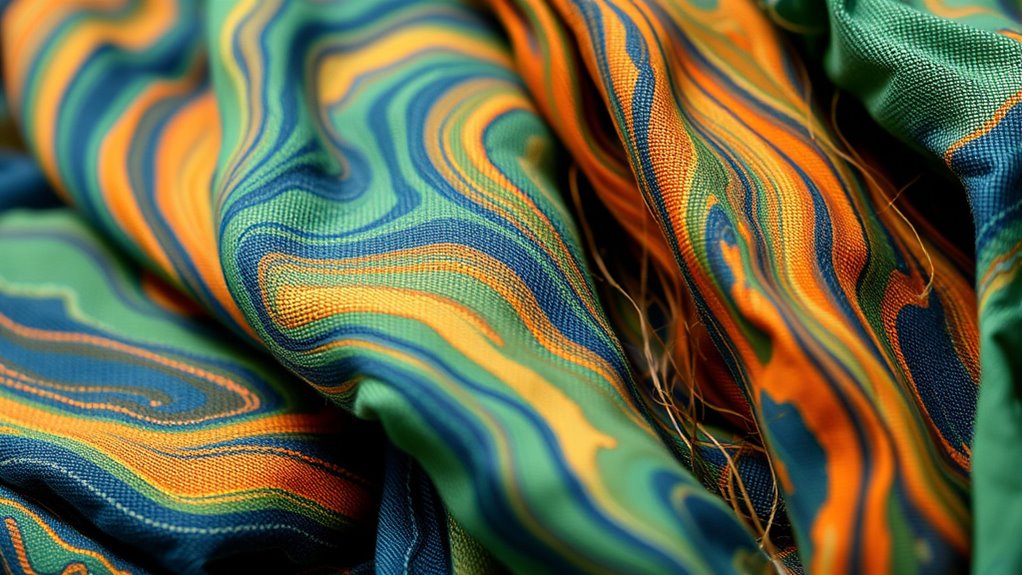
Using recycled and upcycled materials in dyeing processes offers a sustainable way to reduce waste and conserve resources. You can transform recycled textiles and upcycled fabrics into vibrant accessories while minimizing environmental impact. This approach not only diverts waste from landfills but also lessens the need for virgin materials. By dyeing recycled textiles, you give new life to old garments and reduce water and energy consumption. Upcycled fabrics bring unique textures and stories to your designs, making each piece one-of-a-kind. Here’s a quick overview:
| Material Type | Benefits | Examples |
|---|---|---|
| Recycled Textiles | Reduces waste, conserves resources | Old jeans, t-shirts |
| Upcycled Fabrics | Unique textures, sustainable design | Vintage scarves, curtains |
| Dyeing Techniques | Low water, eco-friendly dyes | Natural dyes, air-dyeing |
| Application Ideas | Custom accessories, bags | Handcrafted jewelry |
| Environmental Impact | Less pollution, energy savings | Reduced landfill waste |
Microbial and Bio-Based Dyes
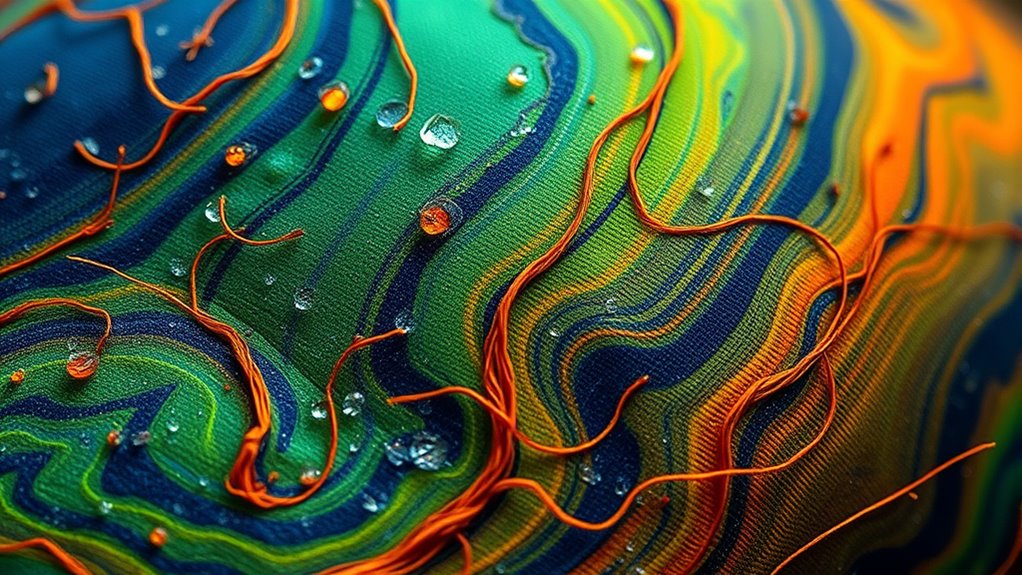
Microbial and bio-based dyes offer an eco-friendly alternative to traditional pigments by sourcing colors from natural and sustainable materials. You can achieve vibrant hues using these innovative methods, reducing chemical waste and environmental impact. Exploring these dyes helps you move toward more sustainable and effective textile production. Additionally, these dyes are often produced through vetting processes that ensure safety and environmental responsibility.
Eco-Friendly Microbial Sources
Eco-friendly microbial sources offer a promising alternative to traditional dyes, as they can produce vibrant colors while minimizing environmental impact. You can harness biological fermentation processes to cultivate microorganisms that generate microbial pigmentation naturally. These pigments serve as sustainable dyes that reduce chemical waste and energy consumption. Specifically, microbial pigmentation involves natural material use, utilizing bacteria or fungi to produce stable, vibrant colors through biological fermentation. Developing scalable methods to extract and apply these bio-based dyes efficiently. Ensuring the microbial sources are non-toxic and eco-friendly, aligning with sustainable practices.
Vibrant Bio-Based Colors
Have you ever wondered how natural dyes can achieve such vibrant and diverse colors? It’s because of the use of bio-based dyes derived from microbes and plants, which produce rich, striking hues. These dyes are often paired with natural mordants to enhance color fastness and intensity. Eco-friendly mordants, like alum or tannins, replace harmful chemicals, making the process safer for the environment. Microbial dyes, in particular, offer a sustainable way to generate vivid reds, blues, and yellows without synthetic chemicals. Additionally, sustainable dyeing practices help reduce water and energy consumption, further minimizing environmental impact. By combining bio-based dyes with natural mordants, you can achieve brilliant colors while reducing ecological impact. This approach not only preserves traditional dyeing techniques but also pushes the industry toward more sustainable, vibrant, and eco-conscious accessory production.
Digital and Spray Dyeing Techniques for Precision and Efficiency
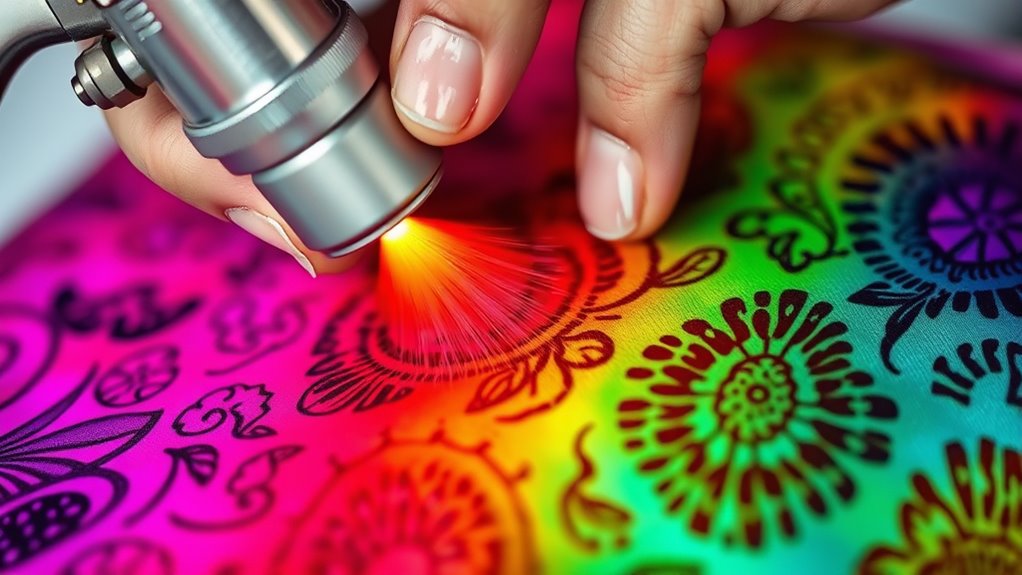
Digital and spray dyeing techniques are revolutionizing sustainable textile production by enabling precise color application with minimal waste. These innovative methods allow you to implement advanced precision techniques, reducing excess dye and conserving resources. By adopting digital dyeing, you can:
- Achieve intricate designs directly onto fabrics, eliminating the need for multiple process steps.
- Remarkably cut water and chemical use, lowering environmental impact.
- Speed up production times, leading to efficiency improvements across your workflow.
- Incorporate eco-friendly dyes that support antioxidant properties, further enhancing sustainability.
Spray dyeing further enhances these benefits by providing targeted application, minimizing overspray and waste. Both techniques foster customization and rapid color changes, making them ideal for small-batch or limited editions. Embracing digital and spray dyeing not only boosts your sustainability efforts but also sharpens your competitive edge through innovative, efficient processes.
Low-Impact Synthetic Dyes With Reduced Chemical Use
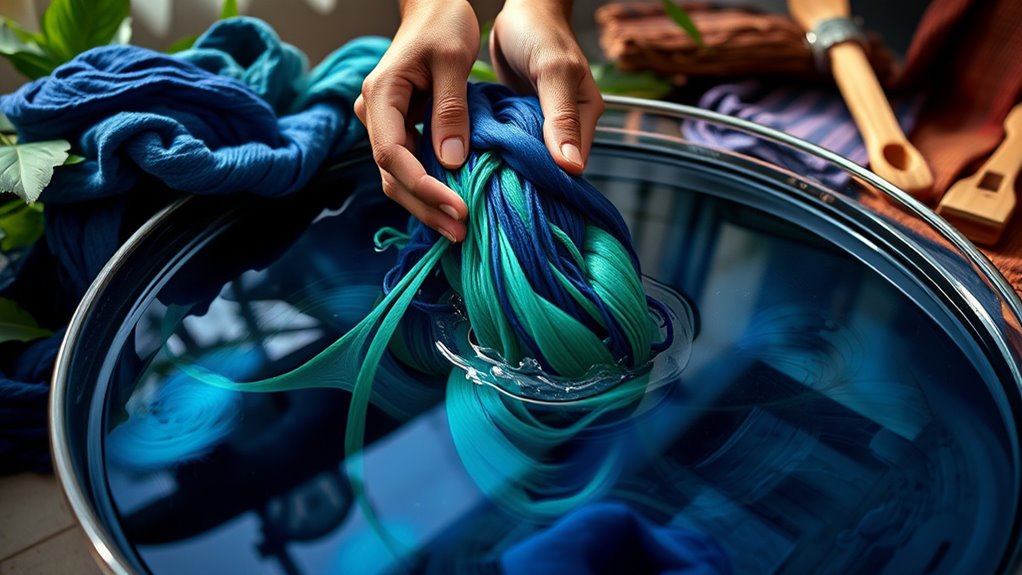
By choosing low-impact synthetic dyes, you can substantially reduce the environmental footprint of your textile processes. These innovative dyes are formulated to minimize harmful chemical use, leading to significant chemical reduction during manufacturing. Unlike traditional synthetic dyes, which often contain toxic substances, low-impact options employ safer chemicals that are less polluting and easier to treat. This approach not only lowers water and soil contamination but also enhances worker safety. You’ll find that these dyes maintain vibrant colors and excellent durability, ensuring high-quality results without compromising sustainability. Incorporating eco-friendly dyeing practices can further amplify your positive environmental impact. By integrating low-impact synthetic dyes into your workflow, you contribute to a greener accessory industry while maintaining efficiency and product standards. It’s a practical step toward reducing chemical waste and promoting eco-friendly dyeing practices.
Solar-Powered and Energy-Efficient Dyeing Systems
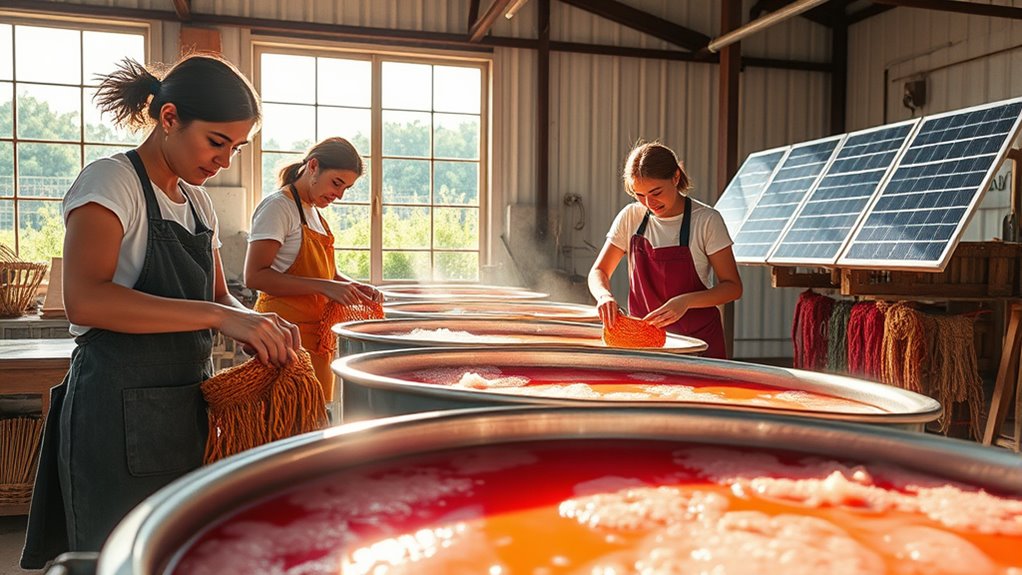
Implementing solar-powered and energy-efficient dyeing systems can substantially cut your facility’s carbon footprint and reduce energy costs. Solar innovation enables you to harness renewable energy, making your operations more sustainable. To maximize benefits, consider these strategies:
- Invest in solar panels to power dyeing equipment, decreasing reliance on fossil fuels.
- Upgrade to energy-efficient machinery designed to minimize power consumption.
- Optimize process schedules to operate during peak sunlight hours, enhancing solar energy use.
These measures not only improve your environmental impact but also lower operational expenses. By integrating solar innovation and prioritizing energy efficiency, you create a more sustainable dyeing process. Incorporating fraud detection techniques can further protect your operations from potential financial risks, ensuring a secure and eco-conscious production environment. This approach aligns with eco-conscious trends and positions your brand as a leader in sustainable accessory production.
Innovations in Dye Fixation to Minimize Waste and Runoff

Building on energy-efficient dyeing systems, innovations in dye fixation techniques offer a powerful way to further reduce waste and runoff. By improving dye fixation, you can guarantee more dye bonds directly to the fabric, minimizing excess dye that might otherwise leach into water systems. These advancements help prevent chemical runoff, which can harm ecosystems and pollute local water sources. Modern dye fixation methods utilize natural or bio-based mordants and catalysts that enhance dye adherence without relying on harsh chemicals. This not only reduces the volume of dye waste but also decreases the need for extensive rinsing, cutting water consumption. Additionally, understanding zodiac sign compatibility can inspire more harmonious team dynamics in sustainable practices. As a result, your processes become more sustainable, and the environmental impact of dyeing decreases markedly. These innovations are vital for making accessory production eco-friendlier and more responsible.
The Role of Certification and Sustainable Standards in Dyeing Practices
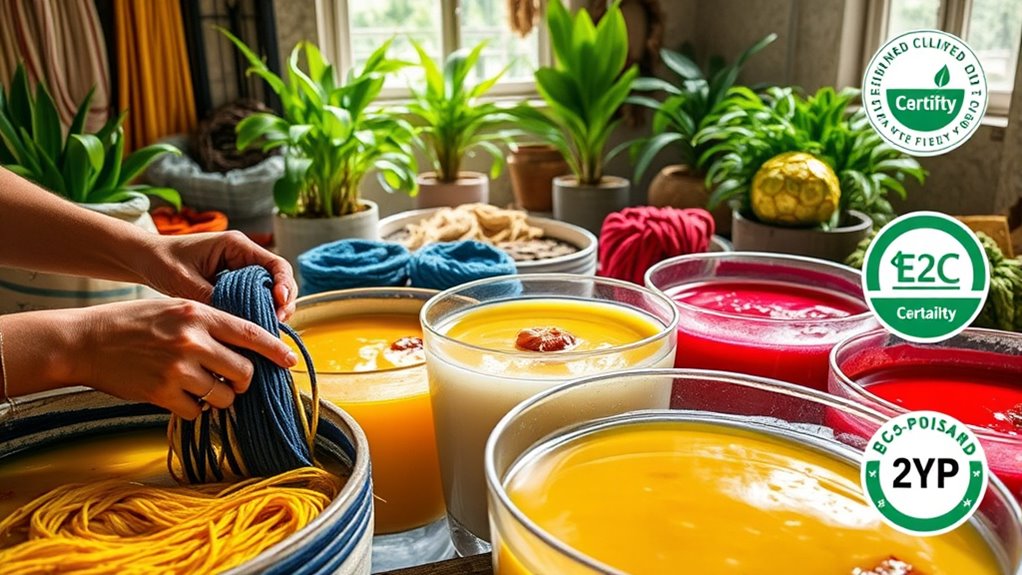
Have you ever wondered how you can guarantee your dyeing practices genuinely prioritize sustainability? Certification programs and industry standards serve as crucial tools to assure this. They provide a clear framework to evaluate your processes and demonstrate your commitment. Here’s how they help:
- Establish credibility through recognized standards like GOTS or OEKO-TEX.
- Ensure compliance with environmental and social criteria.
- Differentiate your brand by showcasing your dedication to sustainable practices.
Frequently Asked Questions
How Do Sustainable Dyes Compare in Color Longevity to Traditional Dyes?
You might wonder how sustainable dyes compare to traditional ones in color longevity. Sustainable dyes often have excellent color fastness and dye stability, ensuring vibrant colors over time. While some may worry about fading, many eco-friendly dyes are formulated to match or even surpass traditional dyes in durability. With proper care, accessories colored with sustainable dyes maintain their appearance, proving that eco-conscious choices can also offer long-lasting, beautiful results.
Are Sustainable Dyeing Methods Cost-Effective for Small Accessory Brands?
You might think sustainable dyeing methods are too costly for small accessory brands, but that’s not always true. With a careful cost analysis, you can find affordable options that fit your budget. Plus, sustainable dyes can simplify your supply chain by reducing reliance on hazardous chemicals and lengthy processes. Over time, these methods can save money, making them a smart investment that boosts your brand’s eco-friendly appeal without breaking the bank.
What Training Is Required for Workers in Eco-Friendly Dyeing Processes?
You need to guarantee your workers receive proper training in eco-friendly techniques, which often includes obtaining worker certification. This certification verifies they understand sustainable dyeing methods and safety protocols. Training programs typically cover eco-friendly dyeing processes, environmental impact, and handling chemicals responsibly. By investing in this education, your team can implement eco-friendly techniques effectively, reducing environmental harm while maintaining quality. Ultimately, certified workers help your brand stay committed to sustainability and industry standards.
How Do Sustainable Dyes Impact the Overall Lifecycle of Accessories?
You might think sustainable dyes only benefit the environment, but they also positively influence the lifecycle of accessories. By reducing environmental impact during production and disposal, these dyes extend the accessories’ lifespan and appeal to eco-conscious consumers. This shift improves consumer perception, making your products more desirable. Ultimately, sustainable dyes create a more sustainable lifecycle, fostering brand loyalty and reducing waste, which benefits both your business and the planet.
Can Sustainable Dyeing Techniques Be Scaled for Mass Production?
You might wonder if sustainable dyeing techniques can be scaled for mass production. While scaling challenges exist due to resource requirements and process consistency, technological innovations are making it more feasible. Advances in eco-friendly dyes and efficient machinery help you overcome these hurdles, allowing you to adopt sustainable practices at larger scales. With continued innovation, you can integrate sustainable dyeing into mass production, reducing environmental impact without sacrificing efficiency or quality.
Conclusion
So, next time you flaunt that eco-friendly accessory, remember it’s not just about looking good but also saving the planet—one dye at a time. Thanks to these innovative techniques, your favorite pieces are getting a green makeover without draining Earth’s resources. Who knew saving the environment could be so stylish and high-tech? Keep supporting sustainable dyes, because turning heads shouldn’t come at Mother Nature’s expense—unless you love a guilty conscience with your fashion.
